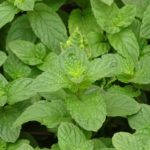 What comes to mind when someone asks if you would like a “mint”? Something cool and refreshing? You may think of peppermint and spearmint used in hard candy, gum, ice cream, and other confectionery products. It probably evokes a pleasant taste or smell. It’s used in many food as well as non-food products such as toothpaste, mouthwash, hand creams, foot creams, room fresheners and more.
What comes to mind when someone asks if you would like a “mint”? Something cool and refreshing? You may think of peppermint and spearmint used in hard candy, gum, ice cream, and other confectionery products. It probably evokes a pleasant taste or smell. It’s used in many food as well as non-food products such as toothpaste, mouthwash, hand creams, foot creams, room fresheners and more.
Many years ago, when I worked in the research and development department of a flavor company, I was invited to a confectionery company to learn about the various mint oils so I could better understand a project we were developing. I was introduced to about 6 to 8 different peppermint oils to “smell.” The oils were extracted from various varieties of mint plants, grown in different regions of the country. Each mint oil had a different flavor profile, from strong to mild, and anywhere in between. Some were suited for use in candy or gum while others were better suited for oral care products. Some were pleasant and I would describe a couple as “nasty” and undesirable for any product I would put in my mouth. This was also applied to the several spearmint oils that I evaluated. Since then, I have learned to appreciate the variety of mint flavors available in the many different products on the market.
Now, my use of mint is through the several mint herb plants that I like to buy every Spring. There are many kinds of mint plants available. Of course, there are the popular  peppermint and spearmint varieties, but did you know there is a chocolate mint, applemint, and a pineapple mint (yup, their name tells you what they smell like!) I like the chocolate variety because it reminds me of a chocolate covered soft, melt in the mouth candy. It’s fun to grow mint in pots – but don’t plant in your yard because it can be an invasive plant and take over your yard. Clemson Cooperative Extension provides some helpful information about growing mint.
peppermint and spearmint varieties, but did you know there is a chocolate mint, applemint, and a pineapple mint (yup, their name tells you what they smell like!) I like the chocolate variety because it reminds me of a chocolate covered soft, melt in the mouth candy. It’s fun to grow mint in pots – but don’t plant in your yard because it can be an invasive plant and take over your yard. Clemson Cooperative Extension provides some helpful information about growing mint.
There are a variety of culinary uses for fresh mint including in iced tea or lemonade, fruit salads, and meats such as lamb. Mint oils are popular in homemade candies. Peppermint extracts are used in many desserts, toppings, and frosting. Try some different recipes. It can even be a fun, fragrant garnis h.
h.
The health benefits of mint have been promoted for a long time. Some have declared that it can aid in digestion or help with colds and the flu. Actual research based benefits or old wives tales – you decide. WebMd provides some interesting medicinal uses of peppermint oil. Discuss the possible benefits and uses of any dietary supplement with peppermint oil in it with your doctor.
Mint may be beneficial to health, but there are some around-the-house benefits too. According to Mother Earth Living, there are a variety of house and garden uses for mint, including that of a room freshener, a repellent for ants and flies, plus attracting beneficial insects.
Explore mint in it’s many varieties and forms.

